With a lot of discussion about which flours are best to make a starter, and when diagnosing a potential issue the remedy is often to switch flours and wholegrains are best, I decided to try making a starter from scratch only using bread flour.
Flour Used: Allinsons Strong White Bread Flour
Ingredients: Wheat Flour (Wheat Flour, Calcium Carbonate, Iron, Niacin, Thiamin), Flour Treatment Agents: Alpha-Amylase, Hemicellulase.
I'm bringing your attention to the flour treatment agents as i'm getting fast results, so far, and perhaps they might have had an effect. I know they're used to help fermentation when yeast, or starter, is added. I don't know if this will affect making a starter from scratch.
Initial Mix: 20g bread flour + 25g water (125% hydration).
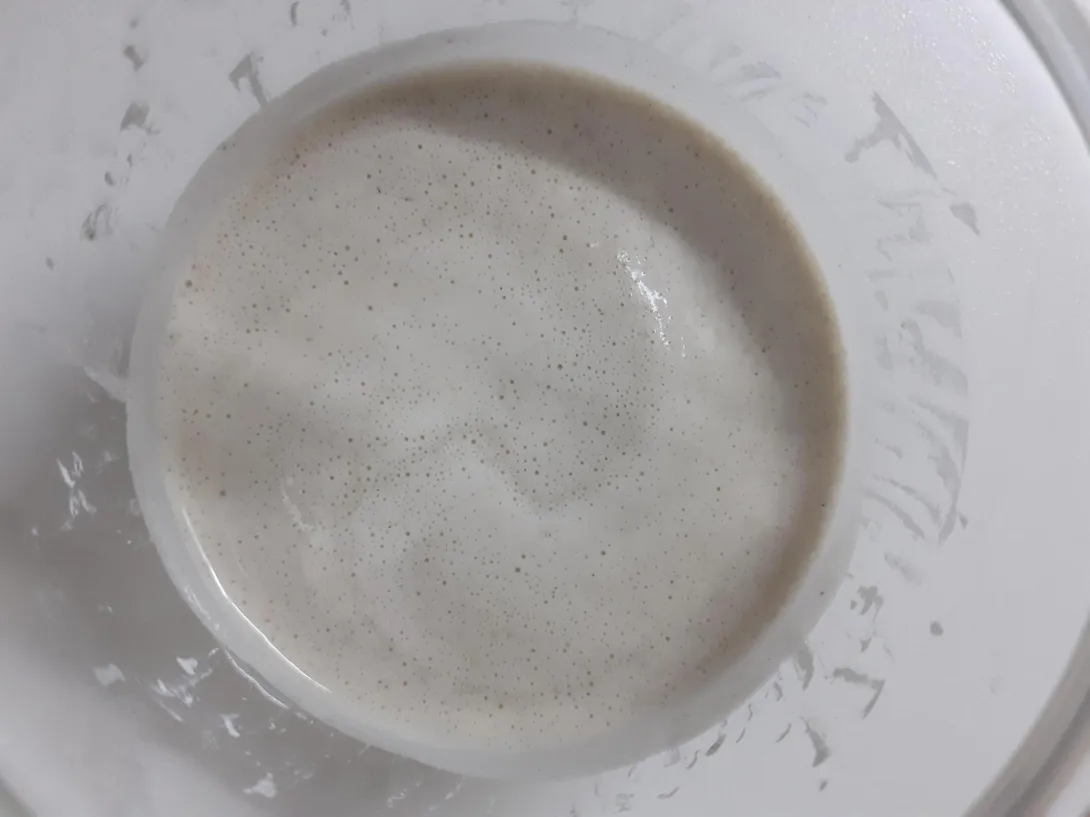
Within 12 hours bubbles already starting to form. Room temperature.
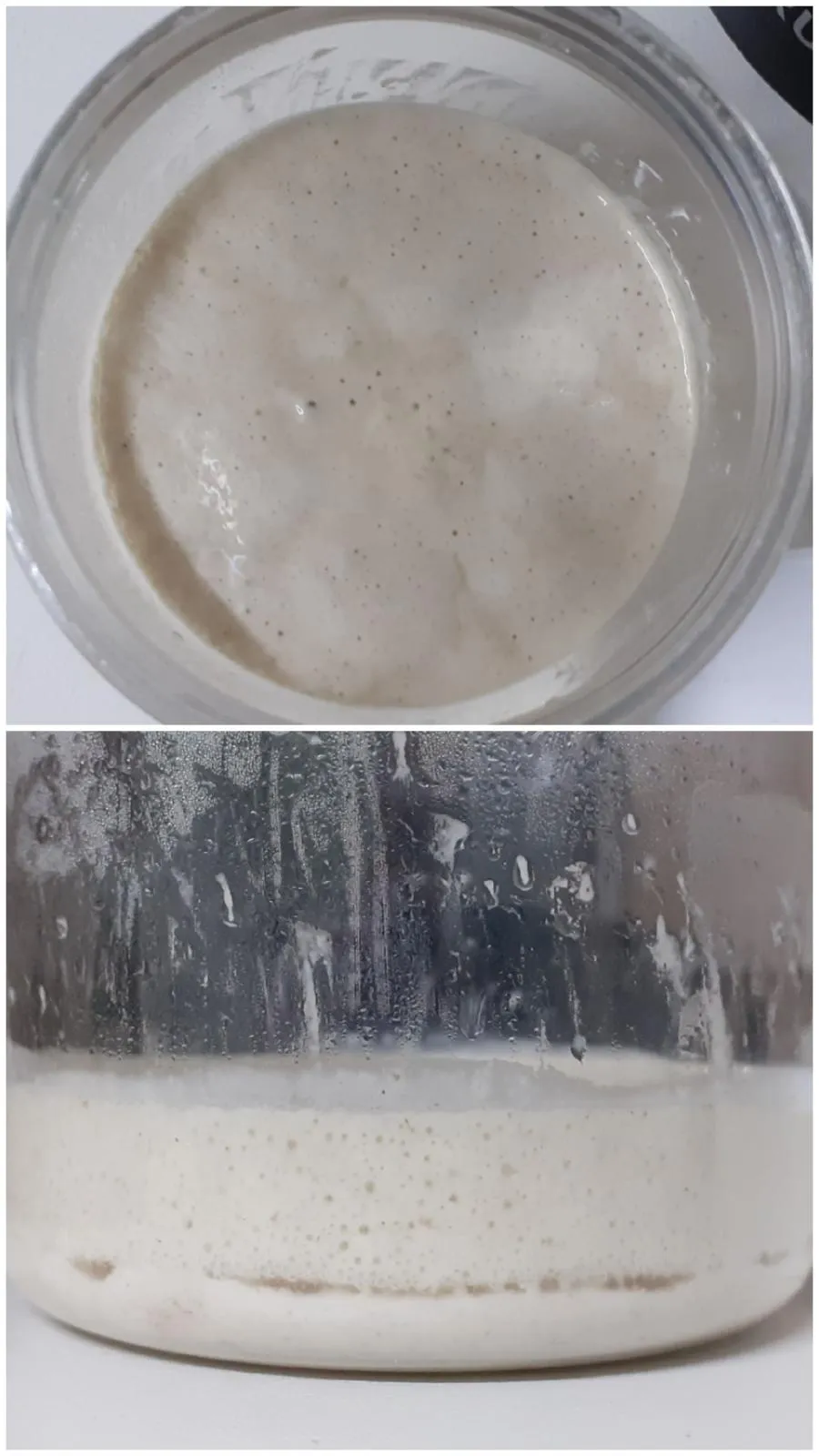
Within 24 hours it has bubbled up, you can see better from the side as it's more frothy on top, and it was relatively cool through the night - about mid 60's °F.
Doesn't smell bad but does have a slight musty aroma. So far on par (or faster even) with any wholegrain.
Next step will be to add 30g of flour and form a stiff 50% hydration dough....
First Feed: Added 30g to the initial mix (20g flour + 25g water) to make a 50% hydration starter (25g water + 50g flour) [3pm]
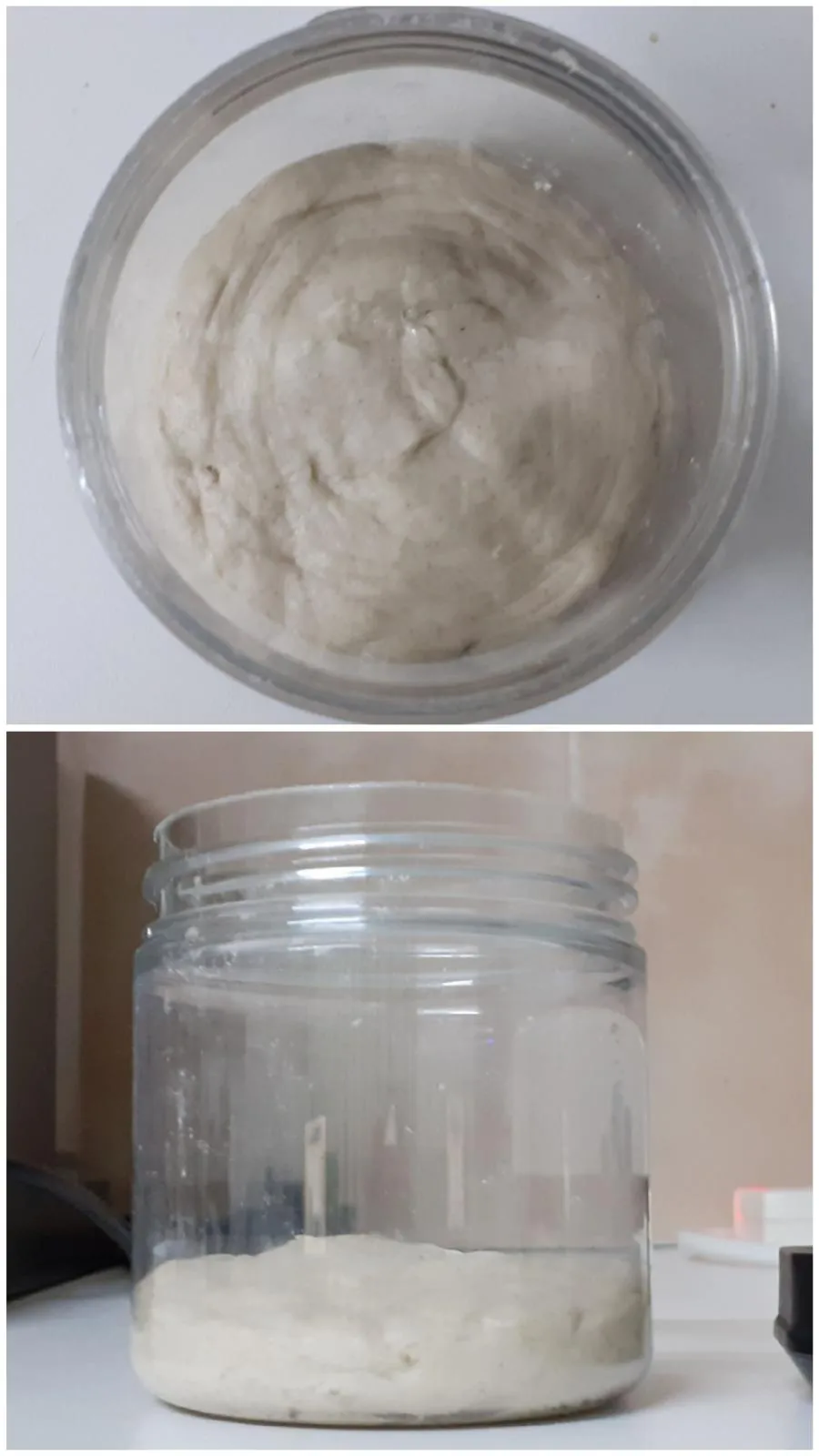
[30 minutes later and it's rising. This could very well be the initial burst of energy not having run its course yet but it is a very stiff low hydration mix and I would have thought it'd need some yeast leavening for it to rise with ease. I'm doing it this way as I had in mind a 50% hydration starter would need more kick, I wouldn't need to feed as often and when it did eventually rise it'd be well on it's way onto being a fully mature starter. We'll see...]
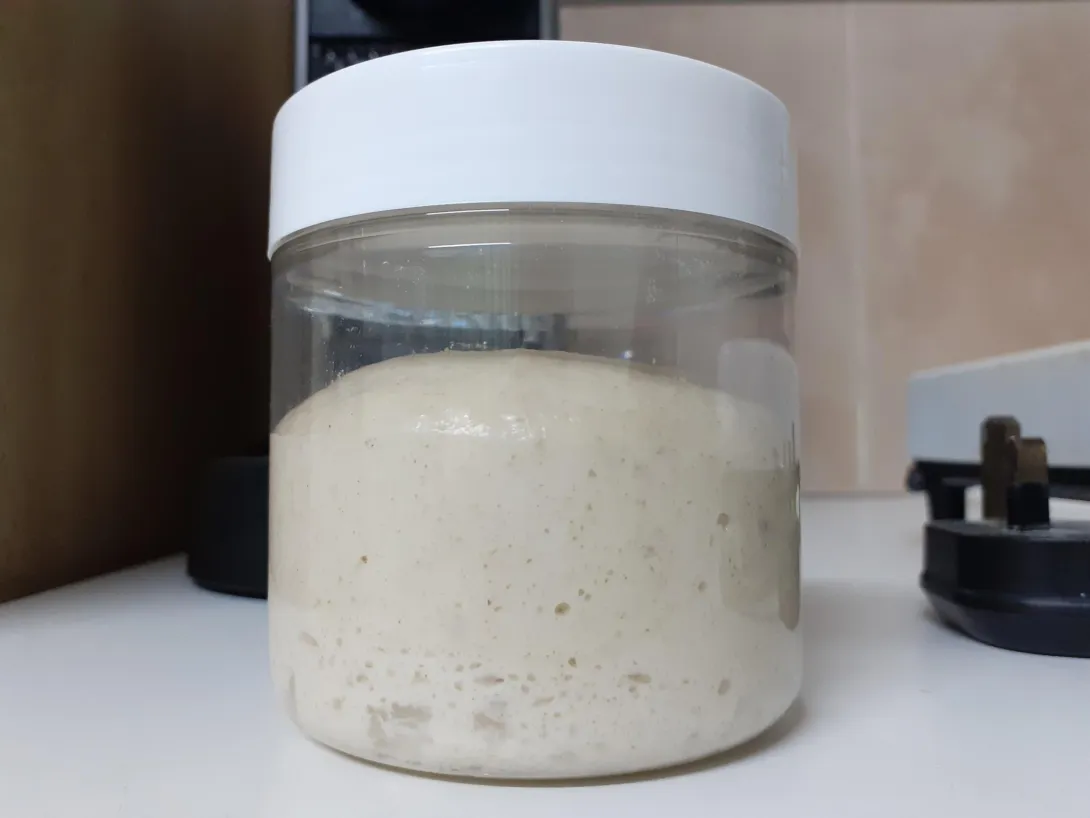
So Here is it 5 hours later...
I'm thinking to not re-feed it again till tomorrow. Just in case it's still feeding off the quick off the mark bacteria i'll allow it to run its course. Smells ok, just a bit musty which is why i'm sure it's not cross contamination. Has signs of a starter being made from scratch but still doing excellently even though it's being made from bread flour alone.
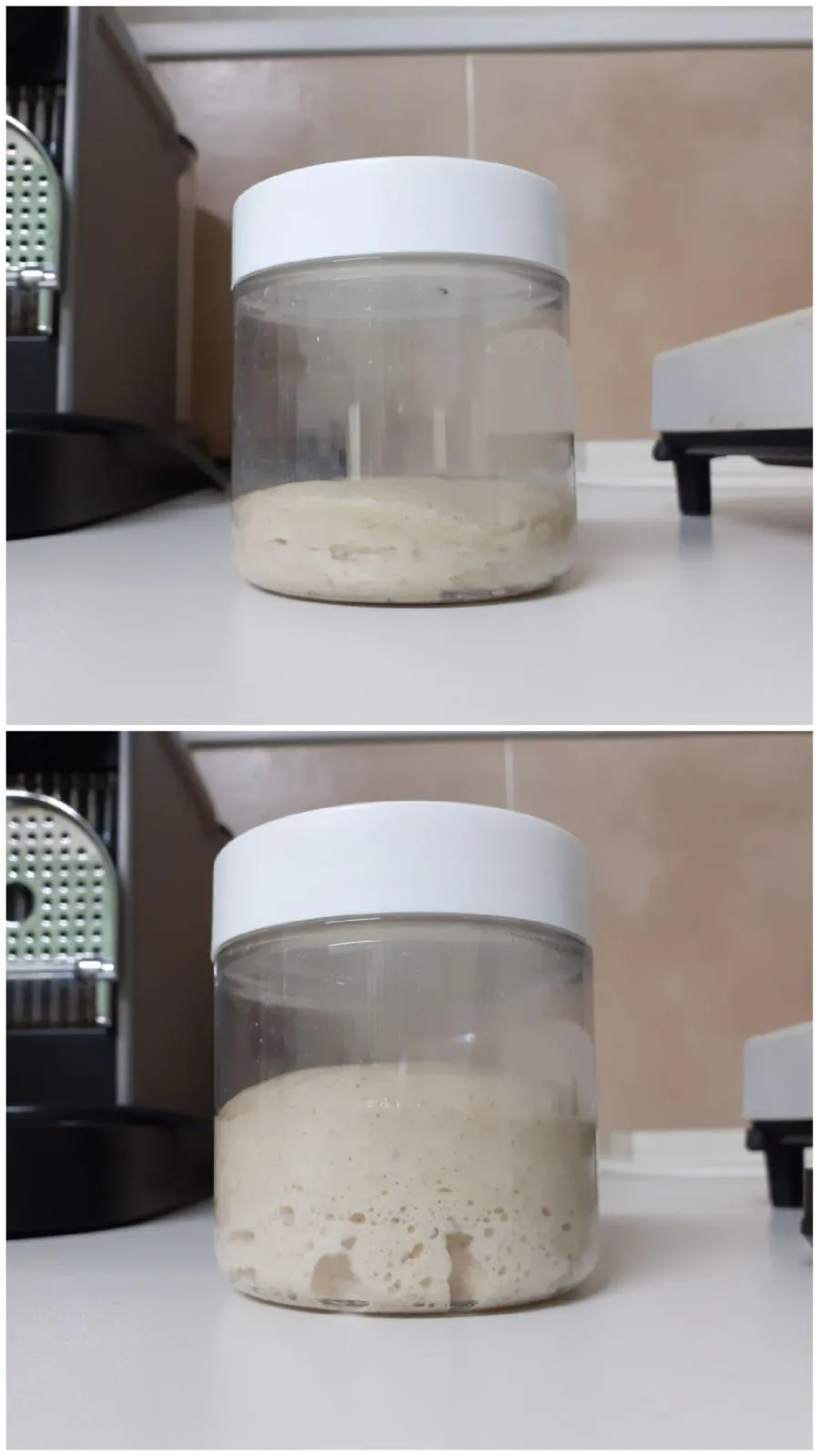
Next Feed: 10:15pm 18-20g starter + 22g water + 44g flour and 12 hours later.
So this is near enough a 1:1:2 feed. With it having more fresh flour in ratio to starter and being very low hydration the starter was very stiff. More so than the first feed. It did begin to rise with a noticeable difference very quickly. Within an hour it had risen some. However i'm not keeping this temperature controlled and through the night it was quite cold. Still it about tripled but not as high as the first feed and slower. The musty smell has gone which has been replaced with a more a fruity aroma and smells a lot more like a young starter now. I'm not going to rush the next feed as the dome is holding and we'll see what it does at warmer temperatures.
UPDATE: A few hours later...
So it's been a couple more days, started Friday late afternoon and now it's Tuesday evening, and it's been through some interesting stages. Been keeping it at 50% hydration and feeding it 1:1:2. When I last updated, photos above, it was rising well but a tad slower and not as high. This was the pattern for the next two feeds. Curiously after each feed it was very quick to show signs fermentation but after that it slowed right down and each time it rose less but was still full of bubbles. Also when it came to the feed it had destroyed the gluten (perhaps that was the 1:2 feed which isn't too high and only feeding once every 24 hours). The aroma was improving though and when mature had a more familiar sourdough starter smell. On the one hand it had signs of entering a quiet stage but on the other hand the aroma was improving and while it didn't rise so much bubbles were always present. Which brings me to today... fed it this afternoon and while it is still slow it's been 7 hours and it's reached the height of yesterday's 24 hour point and still rising. I think the quiet day or two was not a stall but just a slowing down. It now seems to be perking up again. Hopefully it'll be ready in a couple of days and i've got a recipe prepared. Not bad for an all white starter and it's only been 4 days. Here's hoping to have something baked within a week.
Final Update:
...and we're back in business. This starter's quiet time was more of a sulking at the bottom of the jar time but still clear signs of bubbling. It's waking up, getting stronger, rising more and signs the gluten isn't breaking down as much (I think it was the small feeds and long ferment times). The yeasts are turning up in greater numbers now and scheduled for a weekend bake. I wonder if this means bioaerosol was still at play.
Conclusion:
Although still not 100% sure as to why it reacted this way, there are arguments for and against bioaerosol, this starter has been with bread flour from scratch. Started on Friday afternoon and just beginning to mature on Tuesday evening. Was surprised how it really bubbled from day one and didn't actually stop but simply slowed down, always bubbling, before regaining strength. Will benefit from a couple more days feeding but onwards and upwards from here. .
Hope you've enjoyed this experiment.
I have had great luck making starters from scratch from either bread flour or all purpose flour. In fact, I've never really made anything else, beside a rye starter for curiosity's sake.
I want my starter to use the flour that is the cheapest and most widely available to me, so I generally don't even bother introducing anything but white flour into mine.
Good luck with your new starter! I'm sure it will turn out great, probably with some patience.
and i'm trying bread flour out of curiosity. I've made many starters in the past but all have had some wholegrain in the process..... Just remembered I did make a starter with rimacinata flour a while back, from start to finish, and had success. Which is technically white flour. So have done this before after all.
There is a lot of theory how wholegrain is best and I just thought i'd use regular bread flour, nothing too fancy, to really see if there's any difference.
So far so good! Might keep this one as a lievito madre alongside my regular starter.
That's pretty cool how fast you are getting activity. My only concern with such experiments by established bakers is that our tools are all by now contaminated with our active starters, and unless you sterilized everything before using, you might have introduced a tiny amount of yeast and LABs... And that would inoculate it to start fermenting quicker.
That's why I used a just finished peanut butter jar and utensils cleaned very thoroughly. There's no way of knowing if my utensils or very atmosphere in my home has contributed to this but I have been very careful about cross contamination.
That’s true Ilya, contaminated equipment gets touched by our hands which have an altered microbiome with LAB and yeast on them. Then the aerosolized microbes that our kitchens are likely full of. There is likely a reason that new bakers have such a challenge creating a starter while us experienced ones can much more easily.
This is still great Abe, I’m following your experiment with interest.
Benny
I always use a white flour starter, but generally one made from all purpose flour. Hamelman in "Bread" says that high-gluten flour shouldn't be used as it's higher in protein and contains proportionally less starch, and much of the nutrients supplied to the microorganisms comes from starch. It will be interesting to see how yours does.
Richard
Nice to see you on TFL. I've made Jeffrey Hamelman's white flour starter which began as whole rye and honey with the first feed and subsequent feeds transition it to a white starter.
This is purely to see the difference when using white flour from the beginning. There's a lot of discussion with people swearing by wholegrain being the best way because it comes with all the yeast and bacteria. To satisfy my curiosity I decided to see for myself. And being in lockdown (in every aspect except by name - politicians for you) I decided to entertain myself.
Right now it's more than tripled and so far I can't see any difference.
Since no whole grains was used, what do you think is the source of the microbes?
I have an idea and am pretty sure what Debra would say. Curious what others think about this,
This forum (TFL) is a great source for the inquisitive baker. At times it is extremely eye opening and on occasion contradicts our old school thinking. And I love that…
The truth is what it is. Discovering it is a life long endeavor that we know can never be completed.
Danny
I fed it about 3 hours ago - 18-20g starter + 22g water + 44g flour and it's rising nicely. Musty aroma has gone and smells more like a starter. I think it's basically done. Very often this second feed is where it slows down or goes quiet but this one hasn't. Now for my thoughts on why this has happened and i'll throw out some ideas...
1: Pot luck. sometimes you get a good batch of flour and sometimes you don't.
2: In the UK we don't have bleached flour. In fact even our white flour is more off-white. It could still be a source of microbes albeit a lot less than wholemeal.
3: My place is rich in starter microbes and it gave it a kick in the right direction. Very possible but I do have some reserves about this as the first and second bubbling up was not exactly like a mature starter due to presence of the musty aroma signalling it was on the same track as making a starter from scratch. But something went very right which brings me onto my next guess...
4: These flour treatment agents: Alpha-Amylase, Hemicellulase (which I think does a similar job to diastatic malt flour basically making it a perfect environment for fermentation) worked wonders. We'll need Debra to confirm if this is the case.
It's late now so i'll post photos of the feed i've just done tomorrow. Let me know if you agree with any of my points as i'll be very curious to hear everyone's ideas which is why i'm doing this post. Perhaps we can learn something which in turn we can help anyone who's struggling to make a starter.
Abe, I am interested to learn more about #4. My first guess is #3.
It just came to me. TFL is a Bread Think Tank for the inquisitive.
Used a jar and utensils that were cleaned very well indeed to minimise this from happening and the jar has had a lid on it. The starter, although it has been active from day one, has gone through signs of one which hasn't been contaminated by sourdough yeasts mainly the musty smell from the first 36 hours. I would have thought if sourdough culture in the air did this it would skip that stage.
As for #4 we need someone to shed some light on this. What are they, how do they work and what affect would it have on making starters?
Abe, do you have the option to start a starter in an environment that has no trace of yeast of any kind? Maybe a friend that never makes bread. Maybe your office. It would be helpful to confirm or reject the idea of microbes in the environment.
My rationale is based mostly in common sense and is too many times errrant. It is not easy to think microbes are floating around in my kitchen. It is easier to believe that the vessels and tools used for starters/levains are the source.
As you know I make starters quickly. Debra has told me on more than one occasion that it is my environment. Lots of SD bread is made in my kitchen.
It would even be better if it was the friend’s hands doing everything. Abe’s hands likely have an altered microbiome that is rich in the LAB and yeast. At a minimum, if the friend cannot do all the handling, Abe could wear gloves that didn’t spend anytime in his home.
Benny
Is after i've seen this one through, baked with it and after its been amalgamated into my ongoing starter, i'll start a new one with non white treated flour, wearing gloves and in a different room in the house.
Then we can get a good idea of what's going on.
Good ideas!
Your first flour+water mixture behaves like a rehydrated dried starter, Abe! I have never seen anything like that in my kitchen and I tried about a dozen of different recipes for white bread flour starters in the past.
Normally, in my kitchen, using fairly clean brand name Canadian APF from a grocery store, i.e. from large industrial mills, it would take about five full days to develop white flour+plain water starter from scratch, @27C. To get it going faster a third ingredient is usually needed, at least in the first step to make that white flour or water a bit "dirtier", richer in bacteria and yeast.
Bioaerosol is a huge factor, indeed. In bakeries everything is covered with sourdough bacteria: equipment, baker's hands, etc., and its air is rich in spores as well. In kitchens the same happens and not always in a beneficial way. Sometimes they are rich in certain microflora that does not let us develop any starter from scratch no matter which flour or recipe we use.
I once prepared homemade yeast for baking, by leaving a portion of thoroughly cooked corn flour with mashed potato to ferment spontaneously in my kitchen. Basically, I let it spoil at 27-30C for two days. All I had to do was to whip it from time to time, to aerate this porridge. And it worked within a couple of days! I fed it with a freshly cooked porridge and thus I had a batch of perfect homemade yeast for baking bread. The results of test bakes were identical to those baked with commercial yeast. That's how much yeast was in bioaerosol, in the air in my kitchen.
Will you bake with your new starter, Abe? I would love to see the bread that it makes as well.
Love doing things like this. Challenges me and any ideas I might have. TBH my idea was just to see if a white flour, which has less microbes than whole wheat, will turn into a starter and how quickly. This has surprised me too and i'd be very interested in ideas as to why. I think two things might be working here... 1: perhaps my kitchen is swimming in sourdough microbes and 2: the flour is perfect for the microbes to feed off which could be because of the malt like flour treatment agents. But for it to still behave like this and at cold temperatures is still fascinating.
Thank you for the interesting bioaerosol theory and your corn flour and mashed potato spontaneous ferment experiment. Sounds like a good experiment to follow this one.
I've attached the next feed and result. It's tamed somewhat but still rose well. To be expected with a larger feed, being a very low hydration starter and it was quite cold through the night. I'm leaving it for now to see what happens now it's a bit warmer and it's holding its dome.
Just baked a loaf the day before I started this so won't need to bake again for another few days. But i'll nurture this one more and use it for my next loaf. Whenever I do anything like this i'll bake with it a few times but as I don't like to keep too many starters going eventually it will become part of my on-going starter. I like to think after making different starters, and seeing what kind of bread they produce, then adding them to my on-going starter adds to the diversity and taste.
I've enjoyed this experiment and hopefully it's shed some light on only using bread flour for making a starter.
All comments welcome and thank you to everyone who has joined in.
for your insights and laboratory work. I have been using unbleached white bread flour for starter for nearly four years with great results. Nowadays I blend it with rye and whole wheat just because but the feed is still 90% WBF. This stuff:
Since I can buy this in bulk for only $.45USD per pound there is no significant savings in using AP for the small number of bakes I do each year.
And built many starters using wholegrain or a mix of wholegrain and bread flour. Apart from once using durum flour this is built from scratch with bread flour purely to see if using wholegrain really is the best way. My results at the moment are - they seem to act about the same. It was fun to do and I do like to try an experiment from time to time to test theories and ideas. Curiosity satisfied.
Nice percentage of protein in that flour with a touch of malt added too. Looks like a good brand.
Very insightful. This term caught my attention. "Bioaerosol". Does this word mean what it sounds like it means? I Googled it and found little info related to SD starters... But I did observe that my young starter came to life in a big way after it sat in close proximity to a yeasted poolish I fermented over night. Both vessels were covered, the poolish with plastic wrap and the starter with a loose lid ... but I do remember it caught my attention and I thought to myself "could it be?" but I quickly dismissed it as "you're thinking too much".
So, could an active yeast ferment affect an active SD starter if it is placed in close proximity?
We will never know unless it's done under lab conditions and the microbes studied. I highly doubt two preferments in close proximity will cross contaminate with yeasts flying out of the container. Maybe if you have a wooden surface on which you knead a dough will cross contaminate due to yeasts inhabiting the surface or wooden utensils etc. Just my opinion.
The latest feed went very well. Rising more with each feed, with strong gluten and a very yeasty pungent (in a nice way) aroma. I have kept this as a 50% hydration Lievito Madre starter and it has totally different profile to a 100% hydration starter.